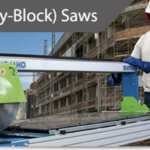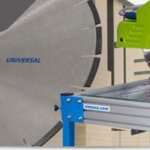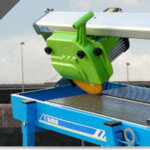Contents
How Are Diamond Blades Made for Masonry Saws?
When it comes to cutting tough materials like concrete, brick, granite, porcelain, marble, and other similar substances, your masonry saw is only as good as the diamond blade you put on it. To understand how your diamond blade works to cut through these types of hard or abrasive materials, it can be helpful to have more information about how a diamond blade is made. Since not all diamond blades are alike, in this article we’ll discuss the two main components of diamond blades and the most common processes that are used to manufacture them.
How are diamond blades made? The core
The core is the flat metal disc that makes up the majority of the blade – the part that you fit onto the arbor of your masonry saw and which rotates to grind the diamond segments through the material being cut. The core is usually made of steel and may be subject to a variety of heat treatments during manufacturing to alter its physical properties, depending on how the diamond segments are going to be attached. For blades designed for low horsepower masonry saws in relatively soft materials, the steel core is often treated simultaneously with the diamond segments, which is efficient in terms of manufacturing time but results in a much weaker core. Higher-intensity diamond blades have a core that is treated separately to improve strength, with the diamond segments being attached later.
How are diamond blades made? The diamond segments
This is the part of the blade that does the cutting – or grinding, rather. Sometimes, it is a single, continuous band around the circumference of the core, but most often it is separated into rectangular segments or “teeth”, with slits between the segments to promote cooling.
Synthetic diamond particles are responsible for grinding through hard materials like concrete; using synthetic diamond allows for greater control over the size, shape and sharpness of the diamonds. The diamonds can be attached to the core in several ways, most of which use a combination of metals called the bond.
As mentioned above, sometimes the diamond segments are treated simultaneously with the core – this is a process called sintering, in which the core, bond and diamonds are all treated together in a sintering furnace. The process basically involves heating the bond metals enough so that they fuse with the core and the diamonds, but without actually reaching their melting point.
Other options which involve separate treatment of the core and the diamond segments are silver brazing and laser welding. Silver brazing uses silver solder to attach the diamond segments (including bond) to the core; although the core strength can be improved here, the solder is not strong enough for these blades to be used in dry cutting.
Laser welded diamond blades are suitable for higher-intensity cutting, even dry cutting (if indicated by the manufacturer), although wet cutting is always preferred. This technique involves welding the bond in the diamond segments directly to the metal of the core, creating a stronger attachment that can stand up to tougher cuts.





